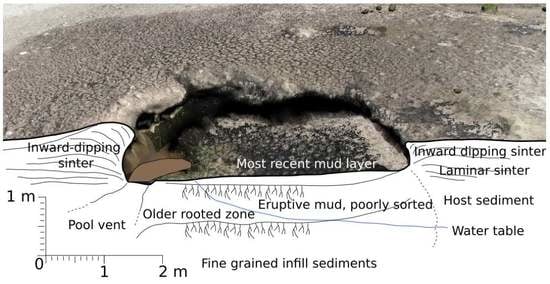Silica Sinter and the Evolution of Hot Springs in the Alvord/Pueblo Valleys, Southeast Oregon, USA
Abstract
1. Introduction
2. Materials and Methods
3. Results
3.1. Geologic Setting
3.2. Pluvial Lake Alvord
3.3. Mickey Springs
3.3.1. Mounds with Narrow Depressions
3.3.2. Broad Depressions
3.3.3. Conglomerate Cemented with Silica Sinter
3.3.4. Current Hydrothermal Activity
3.4. Thermoluminescence Dating
3.5. Ground Penetrating Radar
4. Discussion
4.1. Stratigraphic Relations
4.2. Timing of Sinter Deposition
4.3. Structural Interpretation
4.4. Timeline of Deposits
5. Conclusions
Supplementary Materials
Author Contributions
Funding
Data Availability Statement
Acknowledgments
Conflicts of Interest
Appendix A. TL Dating
| UW Lab Specimen No. | W4832 | W4830 | W4831 | W4823 | W4829 | W4828 |
|---|---|---|---|---|---|---|
| Plateau Region (°C) | 275–400 | 275–450 | 350–450 | 275–350 | 300–500 | 275–450 |
| Analysis Temp. (°C) | 375 | 375 | 375 | 325 | 375 | 375 |
| Palaeodose (Grays) | 18.8 ± 6.4 | 34.5 ± 5.8 | 1.5 ± 0.9 | 45.3 ± 11.7 | 27.5 ± 3.1 | 25.4 ± 2.7 |
| K Content (% by AES) | 1.44 ± 0.05 | 1.78 ± 0.05 | 1.14 ± 0.05 | 1.17 ± 0.05 | 1.29 ± 0.05 | 1.89 ± 0.05 |
| Rb Content (ppm assumed) | 100 ± 25 | 100 ± 25 | 100 ± 25 | 100 ± 25 | 100 ± 25 | 100 ± 25 |
| Moisture Content (% by weight) | 47.0 ± 3 | 32.2 ± 3 | 4.1 ± 3 | 22.2 ± 3 | 34.3 ± 3 | 10.1 ± 3 |
| Specific Activity (Bq/kg U + Th) | 25.9 ± 0.7 | 29.8 ± 0.9 | 32.3 ± 0.9 | 22.3 ± 0.6 | 27.2 ± 0.9 | 42.3 ± 1.1 |
| Cosmic Contribution (μGy/year assumed) | 180 ± 25 | 170 ± 25 | 168 ± 25 | 123 ± 25 | 175 ± 25 | 170 ± 25 |
| Annual Radiation Dose (μGy/year) | 1469 ± 39 | 1969 ± 44 | 1978 ± 58 | 1476 ± 33 | 1522 ± 43 | 2766 ± 55 |
| TL Age (ka) | 12.8 ± 4.4 | 17.5 ± 3.0 | 0.8 ± 0.5 | 30.7 ± 7.9 | 18.1 ± 2.1 | 9.2 ± 1.0 |
References
- St. John, A.M. Hydrogeochemical Characterization of the Alvord Valley Known Geothermal Resources Area, Harney County, Oregon. Master’s Thesis, Portland State University, Portland, OR, USA, 1993. [Google Scholar]
- Cummings, M.; St. John, A. Hydrogeochemical Characterization of the Alvord Valley Known Geothermal Resources Area (kgra), Harney County, Oregon; Procurement No. De. PR79-91BP19408 and Modification A001, Report prepared for Bonneville Power Administration; Bonneville Power Administration: Portland, OR, USA, 1993. [Google Scholar]
- Cummings, M.L.; Wilson, S.D.; St. John, A.M. Borax Lake, a thermal lake confined within a biomorphic mound, Pueblo Valley, Oregon, USA. Palaeogeogr. Palaeoclimatol. Palaeoecol. 2010, 294, 44–55. [Google Scholar] [CrossRef]
- Mowbray, L.A.; Cummings, M.L. Supply-limited, climate-driven model for Holocene spring activity at Mickey Springs, Oregon, USA. Geotherm. Resour. Counc. Trans. 2014, 11–18. [Google Scholar]
- Mowbray, L.A. Quaternary Chronology and Stratigraphy of Mickey Springs, Oregon. Master’s Thesis, Portland State University, Portland, OR, USA, 2015. [Google Scholar]
- Scarberry, K.C.; Meigs, A.J.; Grunder, A.L. Faulting in a propagating continental rift: Insight from the late Miocene structural development of the Abert Rim fault, southern Oregon, USA. Tectonophysics 2010, 488, 71–86. [Google Scholar] [CrossRef]
- Hemphill-Haley, M.A. Quaternary Stratigraphy and Late Holocene Faulting along the Base of the Eastern Escarpment of Steens Mountain, Southeastern Oregon. Ph.D. Thesis, Humboldt State University, Arcata, CA, USA, 1987. [Google Scholar]
- Hemphill-Haley, M.; Page, W.; Burke, R.; Carver, G. Holocene activity of the Alvord fault, Steens Mountain, southeastern Oregon. Woodward Clyde Consult. 1989. prepared for U.S. Geological Survey, Grant No. 14-08-001-G1333. [Google Scholar]
- Singleton, E.S. Late Pleistocene to Holocene Deformation Rates in the Alvord Extensional Basin, Southeastern Oregon, from Ground-Based Lidar Determined Fault Offset of Paleo-Lake Terraces. Ph.D. Thesis, University of Idaho, Moscow, ID, USA, 2005. [Google Scholar]
- Oldow, J.S.; Singleton, E.S. Application of terrestrial laser scanning in determining the pattern of late Pleistocene and Holocene fault displacement from the offset of pluvial lake shorelines in the Alvord extensional basin, northern Great Basin, USA. Geosphere 2008, 4, 536–563. [Google Scholar] [CrossRef]
- Fairley, J.; Heffner, J.; Hinds, J. Geostatistical evaluation of permeability in an active fault zone. Geophys. Res. Lett. 2003, 30. [Google Scholar] [CrossRef]
- Fairley, J.P.; Hinds, J.J. Field observations of fluid circulation patterns in a normal fault system. Geophys. Res. Lett. 2004, 31, L19502. [Google Scholar] [CrossRef]
- Fairley, J.P.; Hinds, J.J. Rapid transport pathways for geothermal fluids in an active Great Basin fault zone. Geology 2004, 32, 824–828. [Google Scholar] [CrossRef]
- Routh, P.S.; Lyle, M.; Hess, S.; Bradford, J. 3D magnetic characterization of hot springs in a hydrothermal system in the Alvord Basin, Oregon. Geotherm. Resour. Counc. Trans. 2006, 30, 937–940. [Google Scholar]
- Anderson, T.R.; Fairley, J.P. Relating permeability to the structural setting of a fault-controlled hydrothermal system in southeast Oregon, USA. J. Geophys. Res. 2008, 113, B05402. [Google Scholar] [CrossRef]
- Fournier, R.O.; Rowe, J.J. Solubility of amorphous silica in water at high temperatures and high pressure. Am. Mineral. 1977, 62, 9–10. [Google Scholar]
- Rimstidt, J.; Cole, D.R. Geothermal mineralization. 1. the mechanism of formation of the Beowawe, Nevada, siliceous sinter deposit. Am. J. Sci. 1983, 283, 861–875. [Google Scholar] [CrossRef]
- Cady, S.; Farmer, J. Fossilization processes in siliceous thermal springs: Trends in preservation along thermal gradients. In Ciba Foundation Symposium 202-Evolution of Hydrothermal Ecosystems on Earth (and Mars?); Bock, G., Goode, J., Eds.; Wiley: Chichester, UK, 1996; pp. 150–173. [Google Scholar]
- Preston, L.J.; Benedix, G.K.; Genge, M.J.; Sephton, M.A. A multidisciplinary study of silica sinter deposits with applications to silica identification and detection of fossil life on Mars. Icarus 2008, 198, 331–350. [Google Scholar] [CrossRef]
- Wu, C. Visualsfm: A Visual Structure from Motion System. 2011, a Software Package for Structure from Motion, Creating Dense Point Construction from photographs. Available online: http://ccwu.me/vsfm (accessed on 10 June 2014).
- Cignoni, P.; Ranzuglia, G. Meshlab v1.3.3. 2014 an Open Source Program for Editing Points and Triangulated Meshes. Available online: http://meshlab.sourceforge.net (accessed on 10 June 2014).
- Girardeau-Montaut, D. Cloudcompare, v2.4. 2012 Open Source Software for 3D Point Cloud and Mesh Processing. Available online: http://www.cloudcompare.org/ (accessed on 4 December 2013).
- Sensors and Software, Ekko View Deluxe, v.1.4. 2009 Proprietary Software for Visualizing GPR Data. Available online: http://www.sensoft.ca/ (accessed on 25 May 2014).
- Hooper, P.; Binger, G.; Lees, K. Ages of the Steens and Columbia River flood basalts and their relationship to extension-related calc-alkalic volcanism in eastern Oregon. Geol. Soc. Am. Bull. 2002, 114, 43–50. [Google Scholar] [CrossRef]
- Moore, N.E.; Grunder, A.L.; Bohrson, W.A. The three-stage petrochemical evolution of the Steens Basalt (southeast Oregon, USA) compared to large igneous provinces and layered mafic intrusions. Geosphere 2018, 14, 2505–2532. [Google Scholar] [CrossRef]
- Walker, G.; Repenning, C. Reconnaissance Geologic Map of the Adel Quadrangle, Lake, Harney, and Malheur Counties, Oregon; U.S. Geological Survey Map I-466, 1965, scale 1:250,000; U.S. Geological Survey: Reston, VA, USA.
- Bradford, J.H.; Liberty, L.M.; Lyle, M.W.; Clement, W.P.; Hess, S. Imaging complex structure in shallow seismic-reflection data using prestack depth migration. Geophysics 2006, 71, B175–B181. [Google Scholar] [CrossRef][Green Version]
- Wisian, K.W.; Blackwell, D.D. Numerical modeling of Basin and Range geothermal systems. Geothermics 2004, 33, 713–741. [Google Scholar] [CrossRef]
- McKenna, J.R.; Blackwell, D.D. Numerical modeling of transient Basin and Range extensional geothermal systems. Geothermics 2004, 33, 457–476. [Google Scholar] [CrossRef]
- Blackwell, D.D.; Hull, D.; Bowen, R.; Steele, J. Heat Flow of Oregon, Oregon; Department of Geology and Mineral Industries: Portland, OR, USA, 1978. [Google Scholar]
- Catchings, R. Seismic implications for crustal composition and deformation along the Basin and Range/Cascade Range boundary. Am. Geophys. Union Trans. 1990, 71, 1613. [Google Scholar]
- Cleary, J.G. Geothermal Investigation of the Alvord Valley, Southeast Oregon. Master’s Thesis, University of Montana, Missoula, MT, USA, 1976. [Google Scholar]
- Benson, L.; Thompson, R. Lake-level variation in the Lahontan basin for the past 50,000 years. Quat. Res. 1987, 28, 69–85. [Google Scholar] [CrossRef]
- Smith, G.I.; Stuiver, M. Subsurface Stratigraphy and Geochemistry of Late Quaternary Evaporites, Searles Lake, California; U.S. Geological Survey Professional Paper 1043; 1979. Available online: https://pubs.er.usgs.gov/publication/pp1043 (accessed on 10 October 2021).
- Kurth, G.; Phillips, F.M.; Reheis, M.C.; Redwine, J.L.; Paces, J.B. Cosmogenic nuclide and uranium-series dating of old high shorelines in the western Great Basin, USA. Geol. Soc. Am. Bull. 2011, 123, 744–768. [Google Scholar] [CrossRef]
- Carter, D.T.; Ely, L.L.; O’Connor, J.E.; Fenton, C.R. Late Pleistocene outburst flooding from pluvial lake Alvord into the Owyhee River, Oregon. Geomorphology 2006, 75, 346–367. [Google Scholar] [CrossRef]
- Personius, S.F.; Crone, A.J.; Machette, M.N.; Kyung, J.B.; Cisneros, H.; Lidke, D.J.; Mahan, S.A. Trench Logs and Scarp Data from an Investigation of the Steens Fault Zone, Bog Hot Valley and Pueblo Valley, Humboldt County, Nevada. 2006. Available online: http://pubs.usgs.gov/sim/2006/2952/ (accessed on 15 June 2014).
- Pettigrew, R.M. Prehistoric human land-use patterns in the Alvord basin, southeastern Oregon. J. Calif. Great Basin Anthropol. 1984, 61–90. [Google Scholar]
- Negrini, R.M. Pluvial lake sizes in the northwestern Great Basin throughout the Quaternary period: Great Basin aquatic systems history. Smithson. Contrib. Earth Sci. 2002, 33, 11–52. [Google Scholar]
- Bedwell, S.F. Fort Rock Basin: Prehistory and Environment; University of Oregon Press: Eugene, OR, USA, 1973. [Google Scholar]
- Beck, C. Steens Mountain Surface Archaeology: The Sites. Ph.D. Thesis, University of Washington, Seattle, WA, USA, 1984. [Google Scholar]
- Western Regional Climate Center, Desert Research Institute. Period of Record Monthly Climate Summary for Fields, Oregon, Station id 352876 (5/1/73 to 3/31/2013). Available online: http://www.wrcc.dri.edu/cgi-bin/cliMAIN.pl?or2876 (accessed on 5 May 2014).
- United States Geological Survey. Available online: http://earthquake.usgs.gov/hazards/qfaults/ (accessed on 15 June 2014).
- Oregon Department of Geology and Mineral Industries. Available online: http://www.oregongeology.org/arcgis/rest/services/Public (accessed on 15 June 2014).
- Echelle, A.A.; Echelle, A.F. Restoration of aquatic habitats and native fishes in the desert some successes in western North America. In Standing between Life and Extinction: Ethics and Ecology of Conserving Aquatic Species in North American Deserts; Propst, D., Williams, J., Bestgen, K., Hoagstrom, C., Eds.; The University of Chicago Press: Chicago, IL, US, 2020; pp. 353–374. [Google Scholar]
- Oestreicher, Z.W.J. Geomicrobiology Investigation of Mickey Hot Springs, Southeastern Oregon. Master’s Thesis, Portland State University, Portland, OR, USA, 2004. [Google Scholar]
- Nicholson, K.N.; Link, K.N.; Garringer, L. Relative ages of the Borax Lake and Mickey geothermal systems, Alvord basin, Oregon USA: Preliminary evidence from silica phase transitions. In Proceedings of the 26th New Zealand Geothermal Workshop, Taupo, New Zealand, 31 January–3 February 2004; pp. 40–45. [Google Scholar]
- Curewitz, D.; Karson, J.A. Structural settings of hydrothermal outflow: Fracture permeability maintained by fault propagation and interaction. J. Volcanol. Geotherm. Res. 1997, 79, 149–168. [Google Scholar] [CrossRef]
- Cummings, M.L.; St John, A.M.; Sturchio, N.C. Hydrogeochemical characterization of the Alvord basin geothermal area, Harney County, Oregon, USA. In Proceedings of the 15th New Zealand Geothermal Workshop, Auckland, New Zealand, 1993; pp. 119–124. Available online: https://www.geothermal-energy.org/pdf/IGAstandard/NZGW/1993/Cummings.pdf (accessed on 10 October 2021).
- St. John, A.; Cummings, M.L. Silica sinter deposits and recent geysering activity at Mickey Hot Springs, Alvord Valley, Harney County, Oregon. Geol. Soc. Am. Abstr. Programs 1992, 24, 82. [Google Scholar]
- Cross, J. Mickey Hot Springs, Harney County, Oregon-Observations of 27–29 March 1992: The Geyser Observation and Study Association Transactions IV. 1993, pp. 212–219. Available online: https://www.gosa.org/transactions.aspx (accessed on 10 October 2021).
- Kipple, M.J. Temperature patterns and increase of surface activity at Mickey Hot Springs, Oregon. Geol. Soc. Am. Abstr. Programs 2017, 49. [Google Scholar] [CrossRef]
- Kipple, M.J. If a spring erupts, and no one is there to hear it…The eruptive Features of Mickey Hot Springs, Oregon. Geyser Gazer Sput 2017, 37, 6–8. [Google Scholar]
- Dougherty, A.; Lynne, B. Utilizing ground penetrating radar to image vents and fractures in geothermal environments. Am. Geophys. Union Fall Meet. Abstr. 2010, 2010, 2358. [Google Scholar]
- Lynne, B.; Dougherty, A. Ground penetrating radar successful in imaging hot spring deposits: A new geothermal exploration tool. Am. Geophys. Union Fall Meet. Abstr. 2010, 2010, V23D-06. [Google Scholar]
- Lynne, B.Y.; Sim, C.Y. Ground penetrating radar and its successful application in imaging USA and New Zealand siliceous sinters. In Proceedings of the New Zealand Geothermal Workshop, Auckland, New Zealand, 19–21 November 2012. [Google Scholar]
- Jaworowski, C.; Lynne, B.Y.; Heasler, H.; Foley, D.; Smith, I.J.; Smith, G.A. Detecting natural fractures with ground penetrating radar and airborne night-thermal imaging around Old Faithful Geyser, Yellowstone National Park, USA. Geothermics 2020, 85. [Google Scholar] [CrossRef]
- Wilson, S.D. Geology and Slope Stability of the Borax Lake Hydrothermal Mound, Alvord Basin, Oregon. Master’s Thesis, Portland State University, Portland, OR, USA, 2000. [Google Scholar]
- Schneider, T.R.; McFarland, W.D. Hydrologic Data and Description of a Hydrologic Monitoring Plan for the Borax Lake area, Oregon. Open-File Report 95-367; 1995. Available online: https://pubs.er.usgs.gov/publication/ofr95367 (accessed on 10 October 2021).
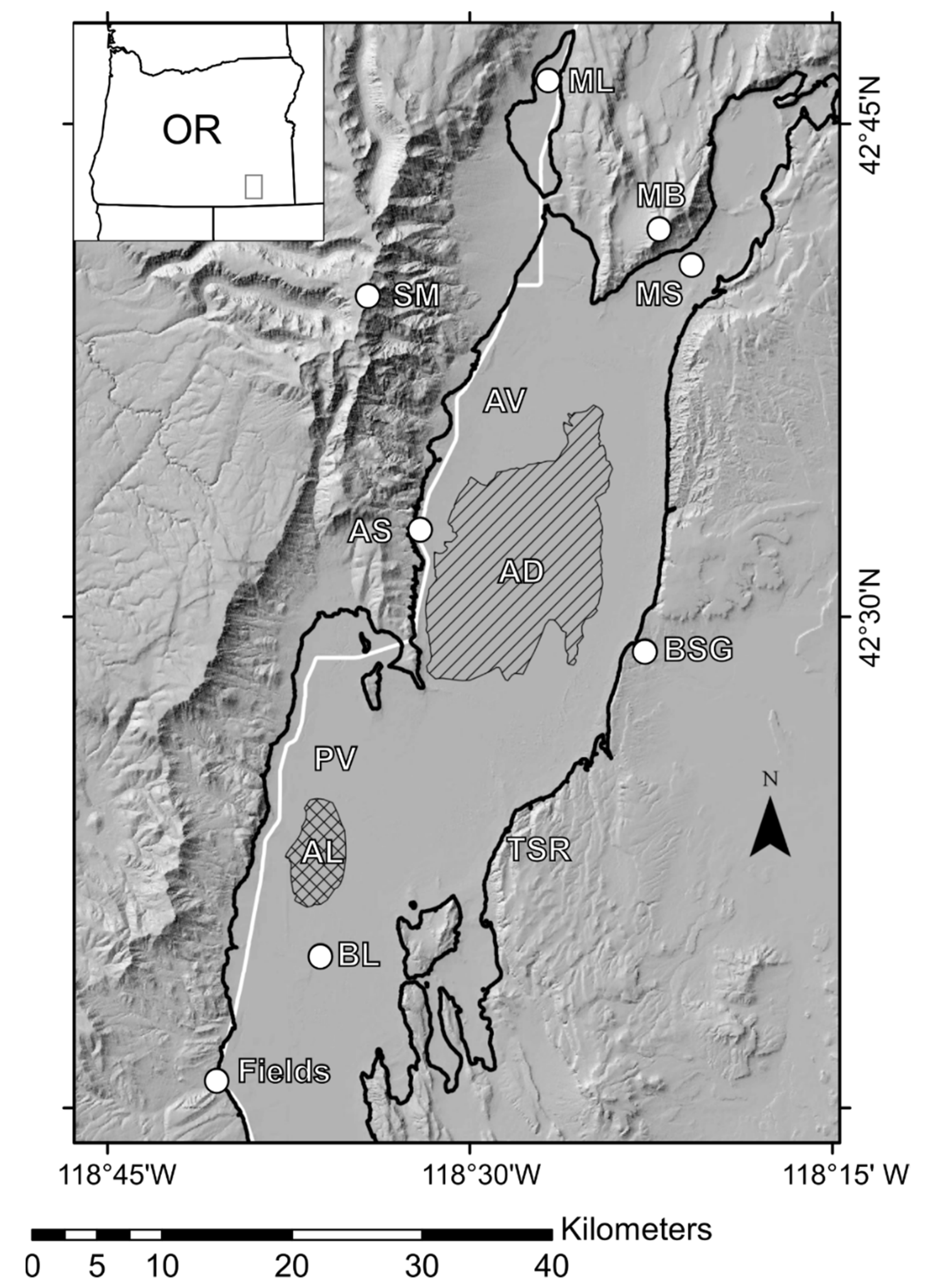


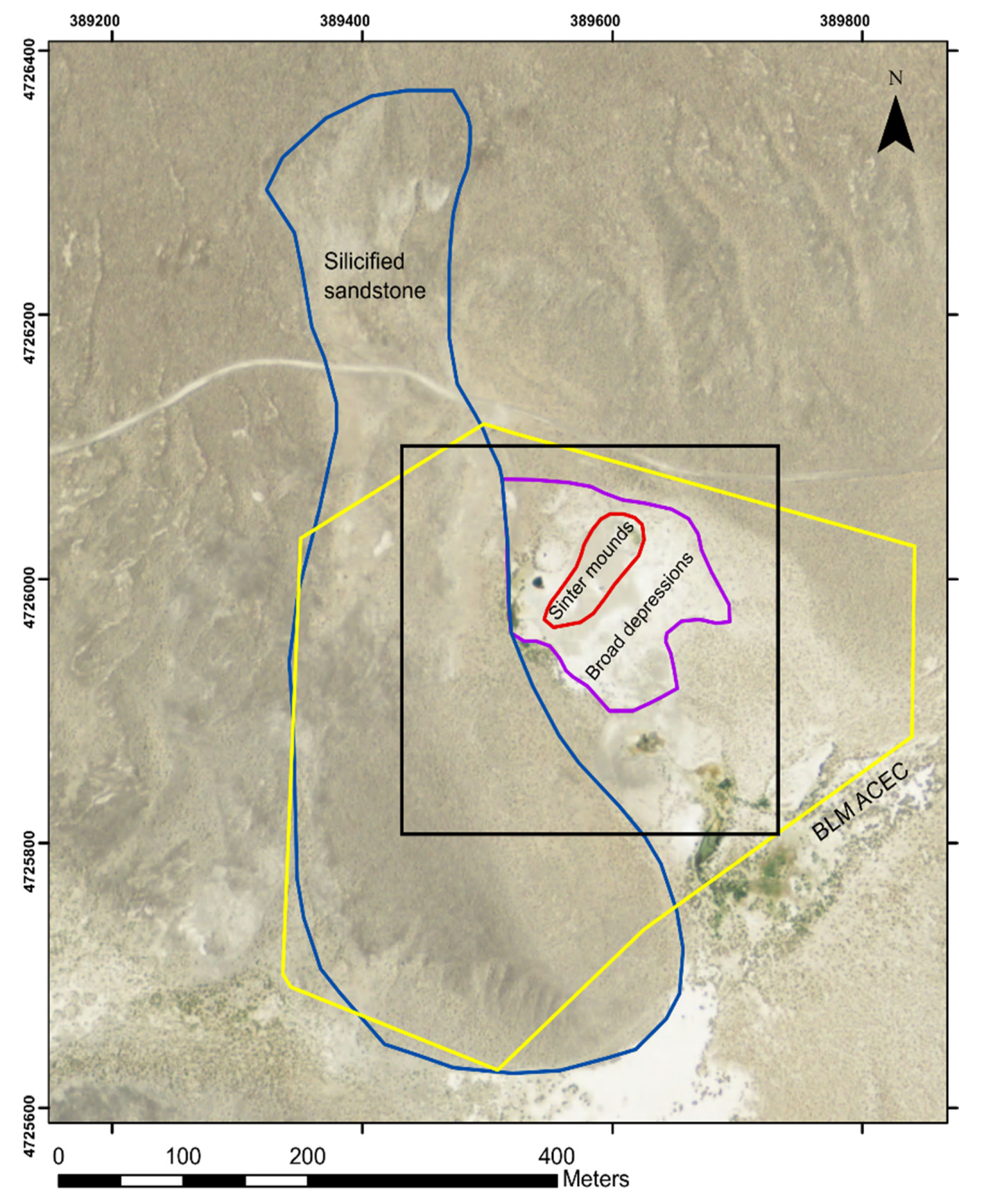

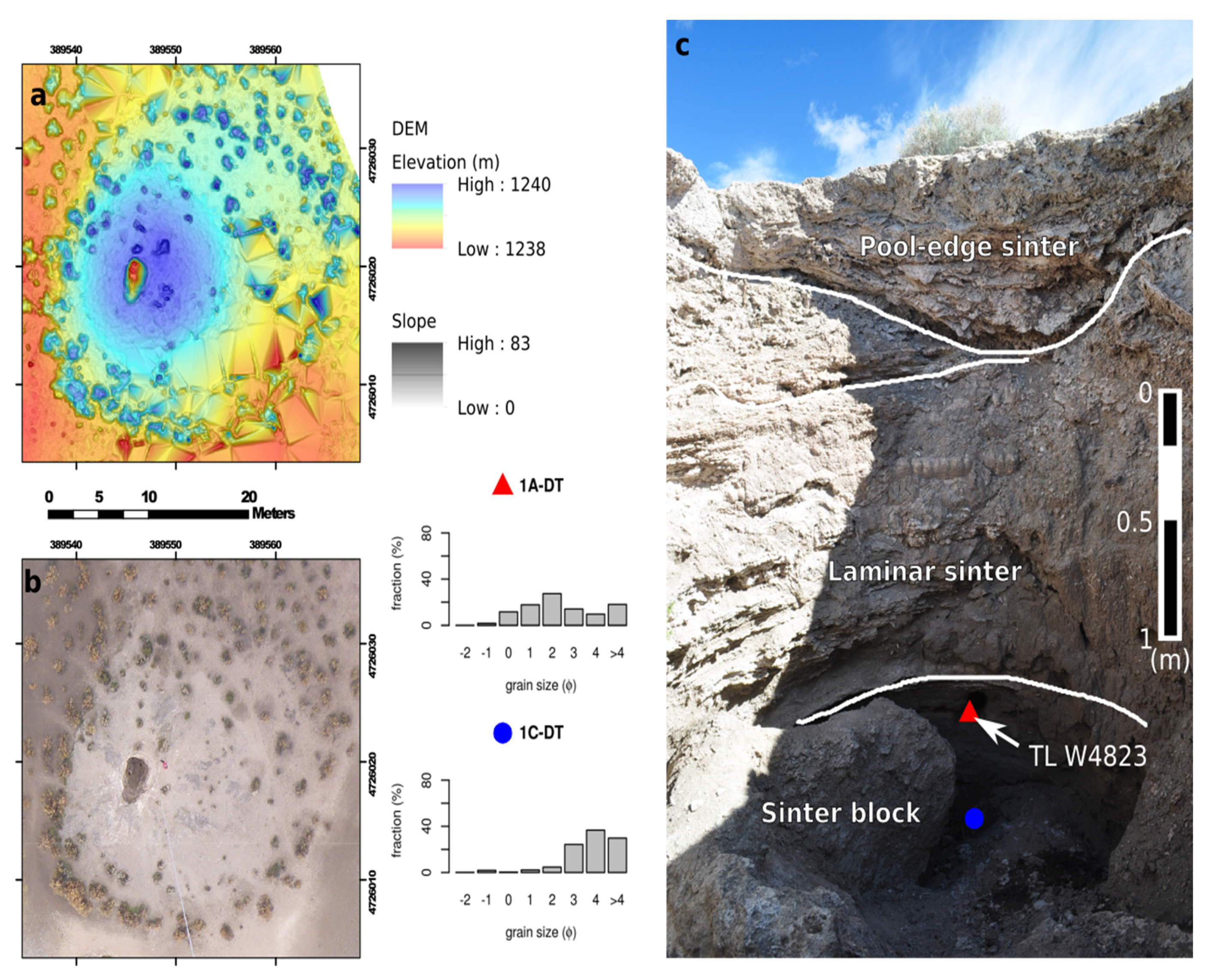
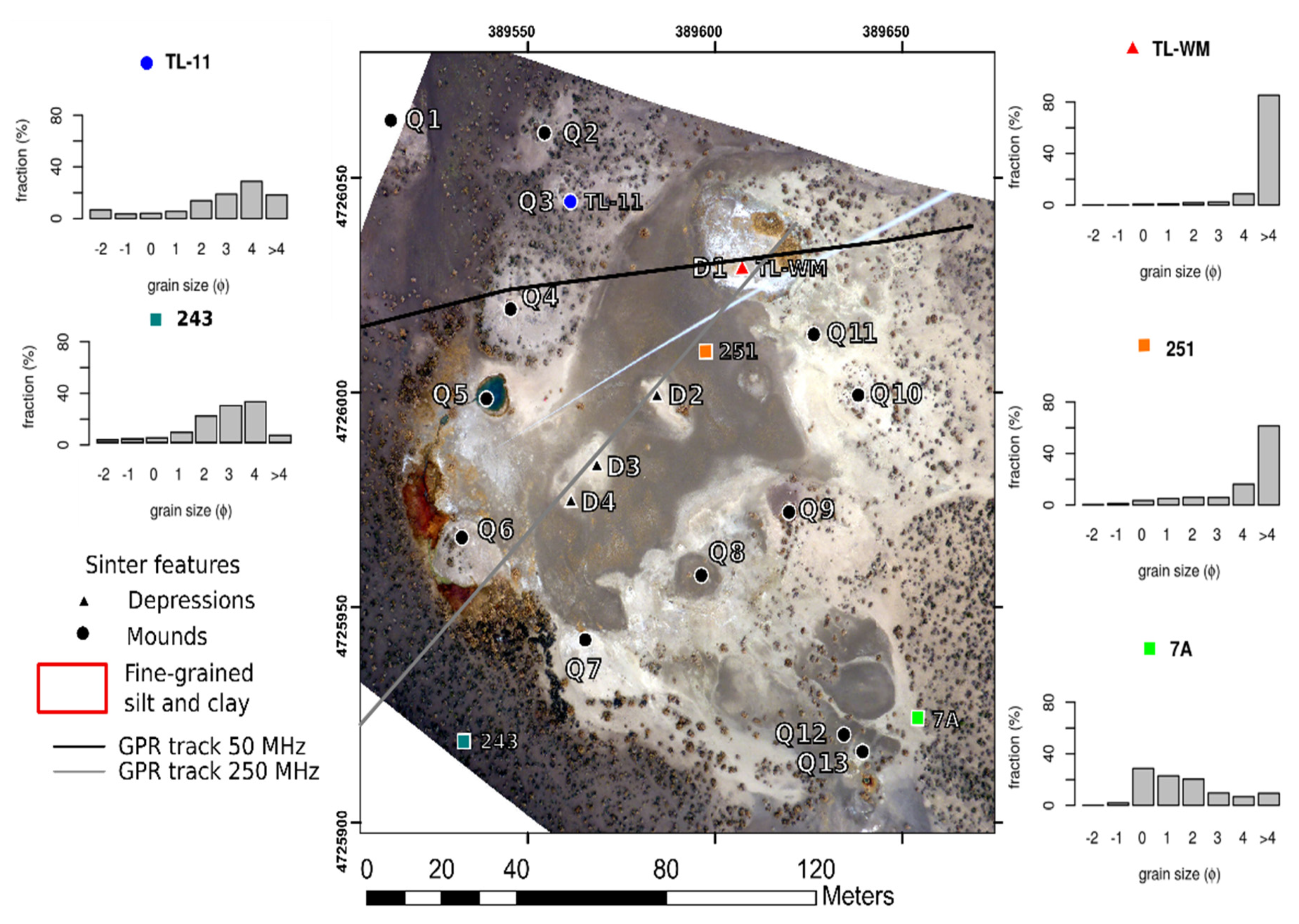

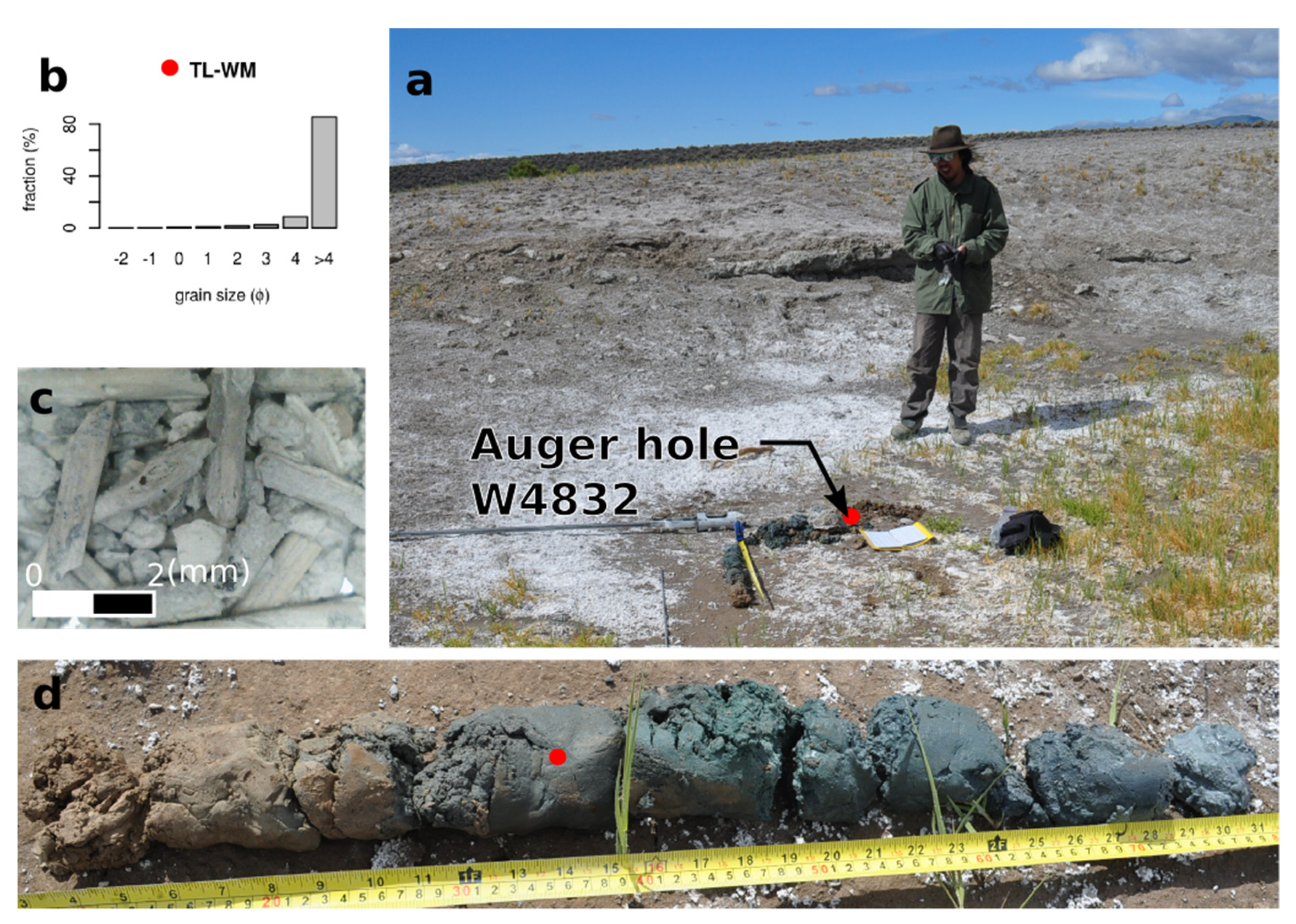
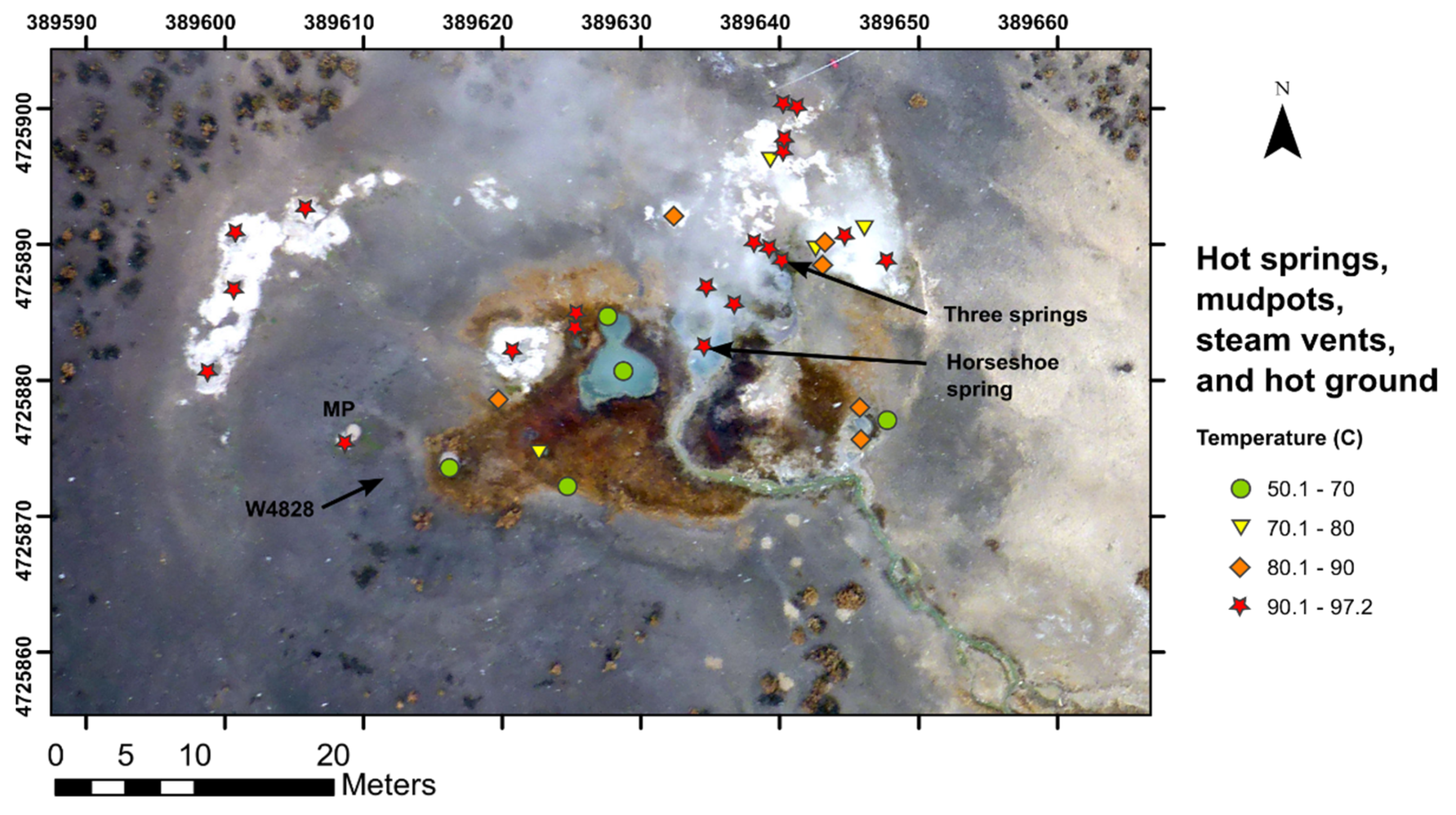


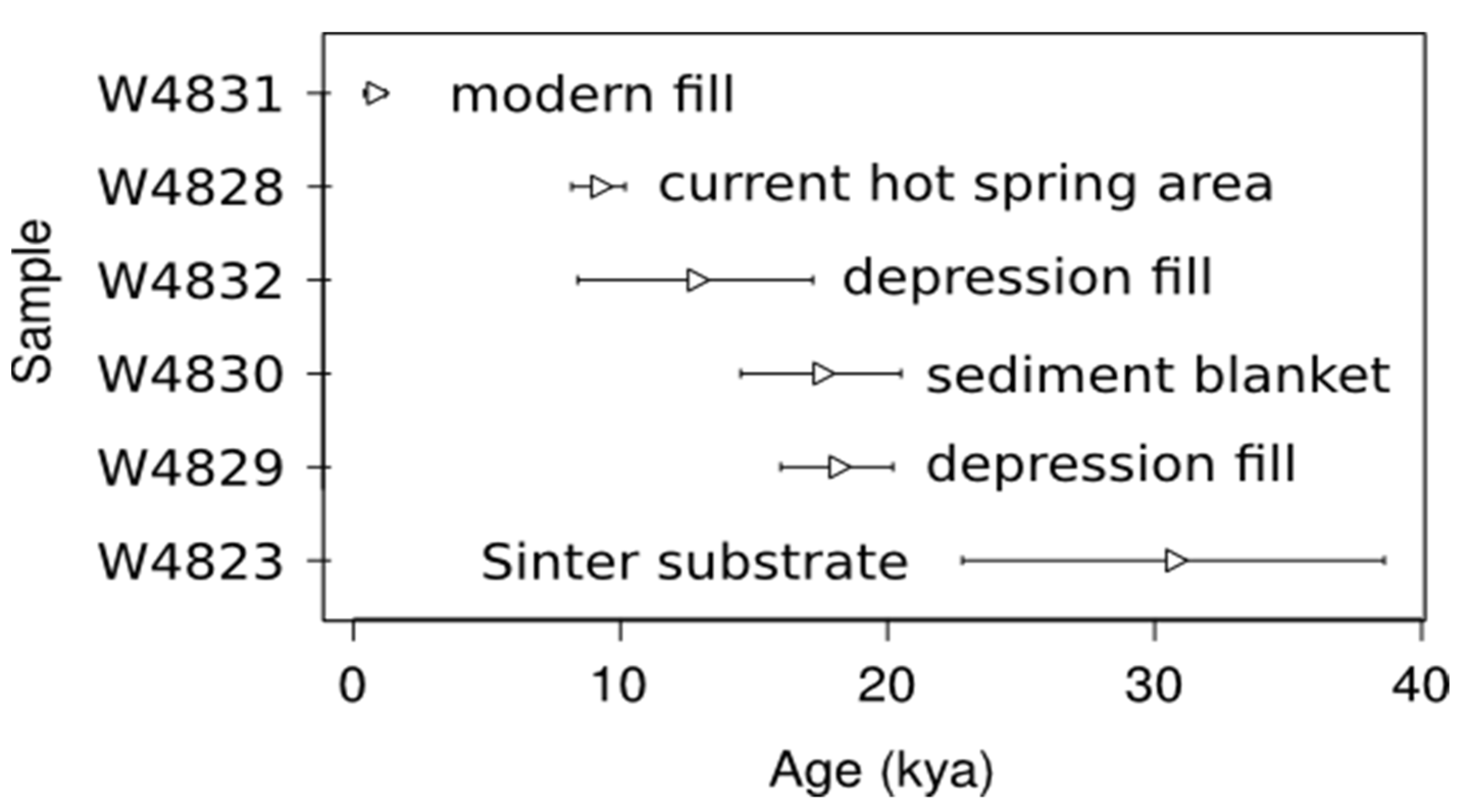

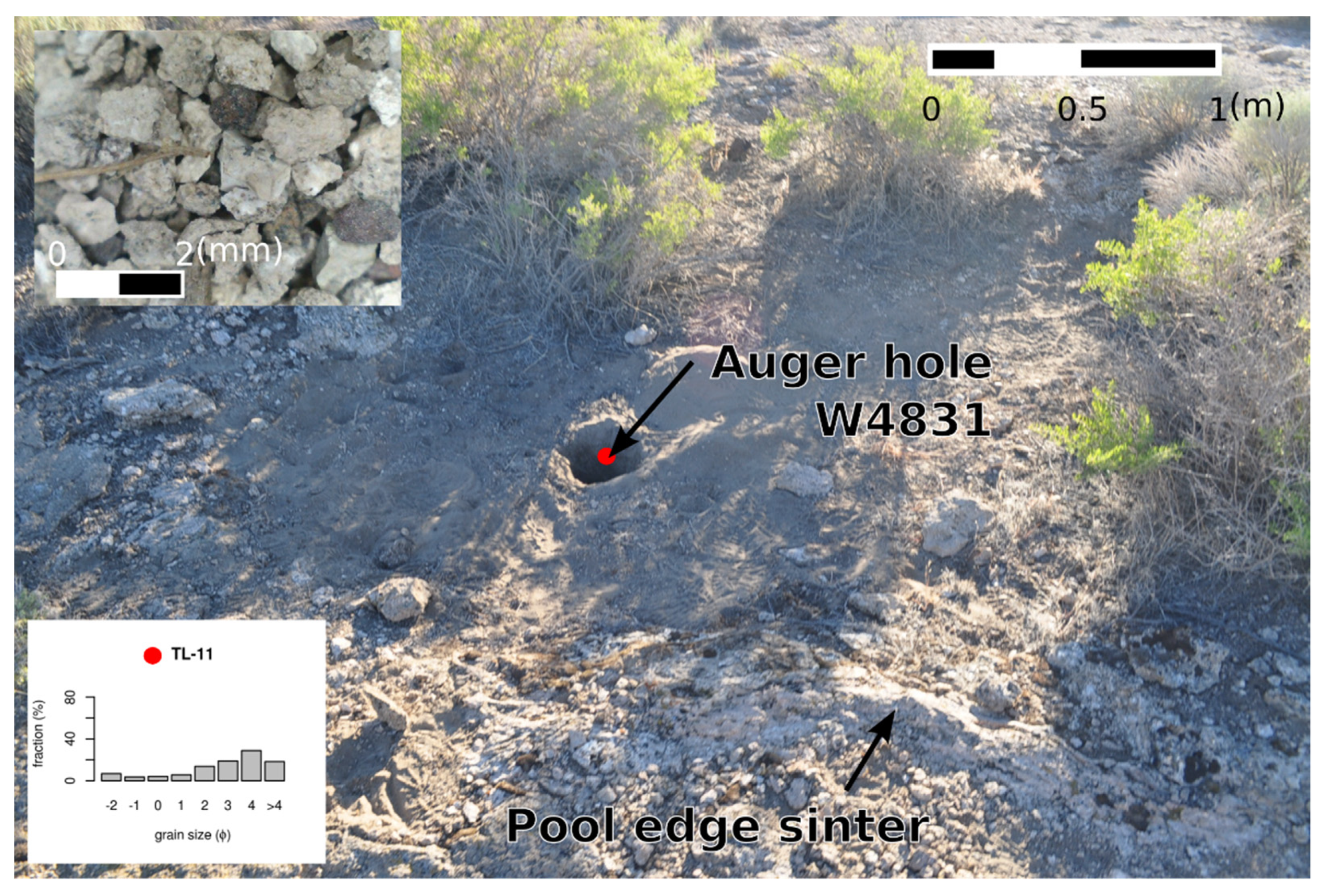
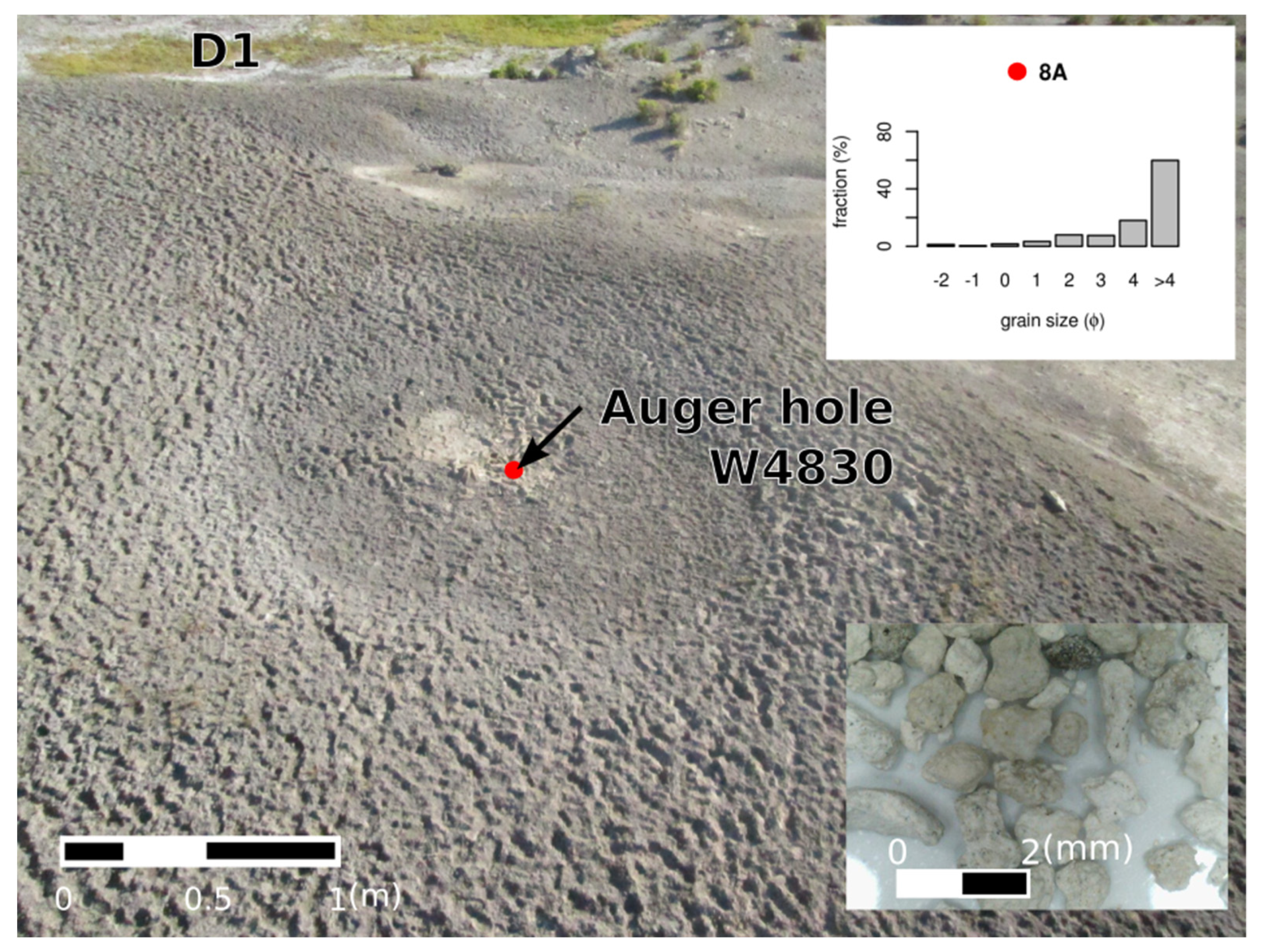

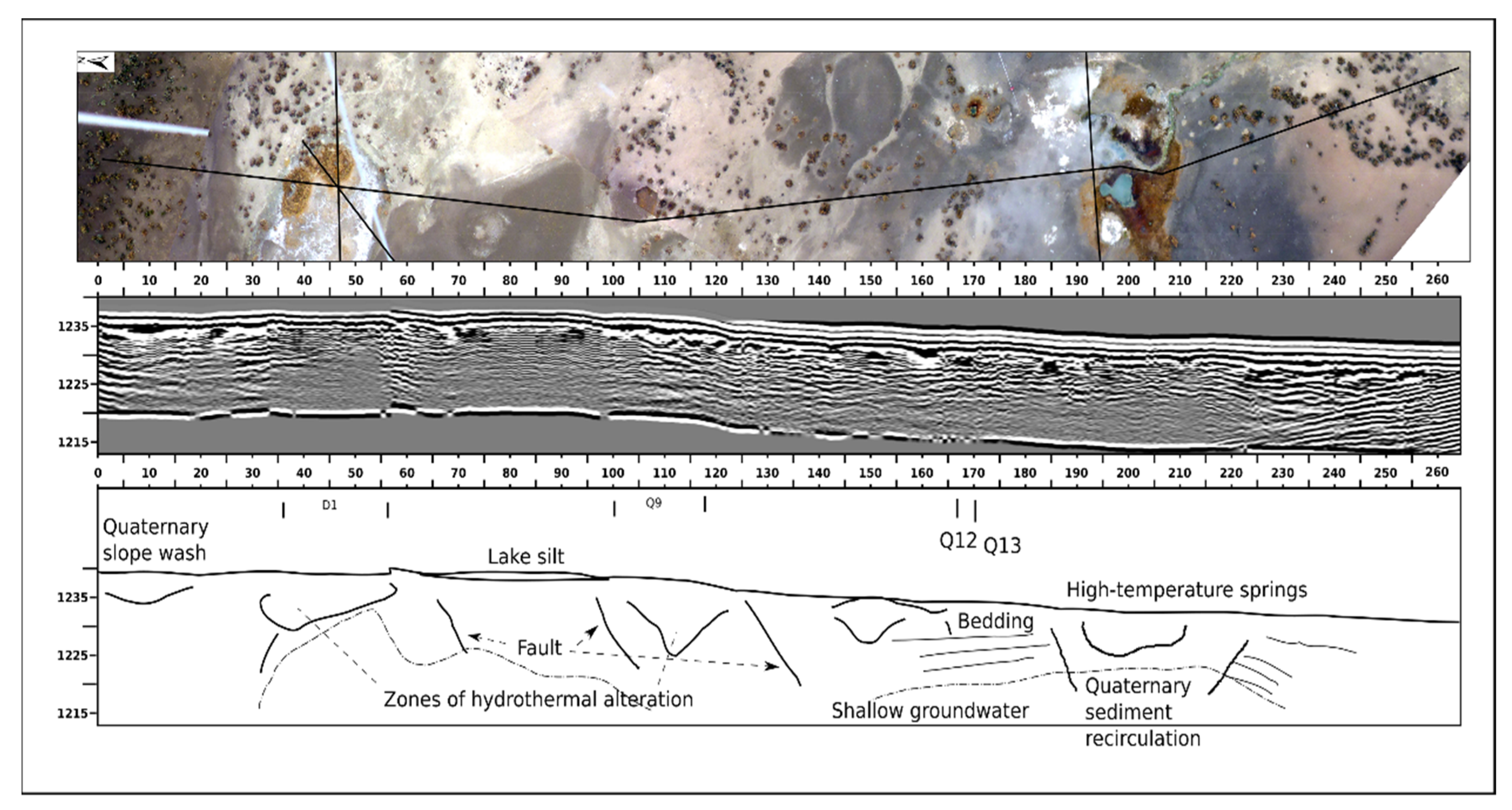
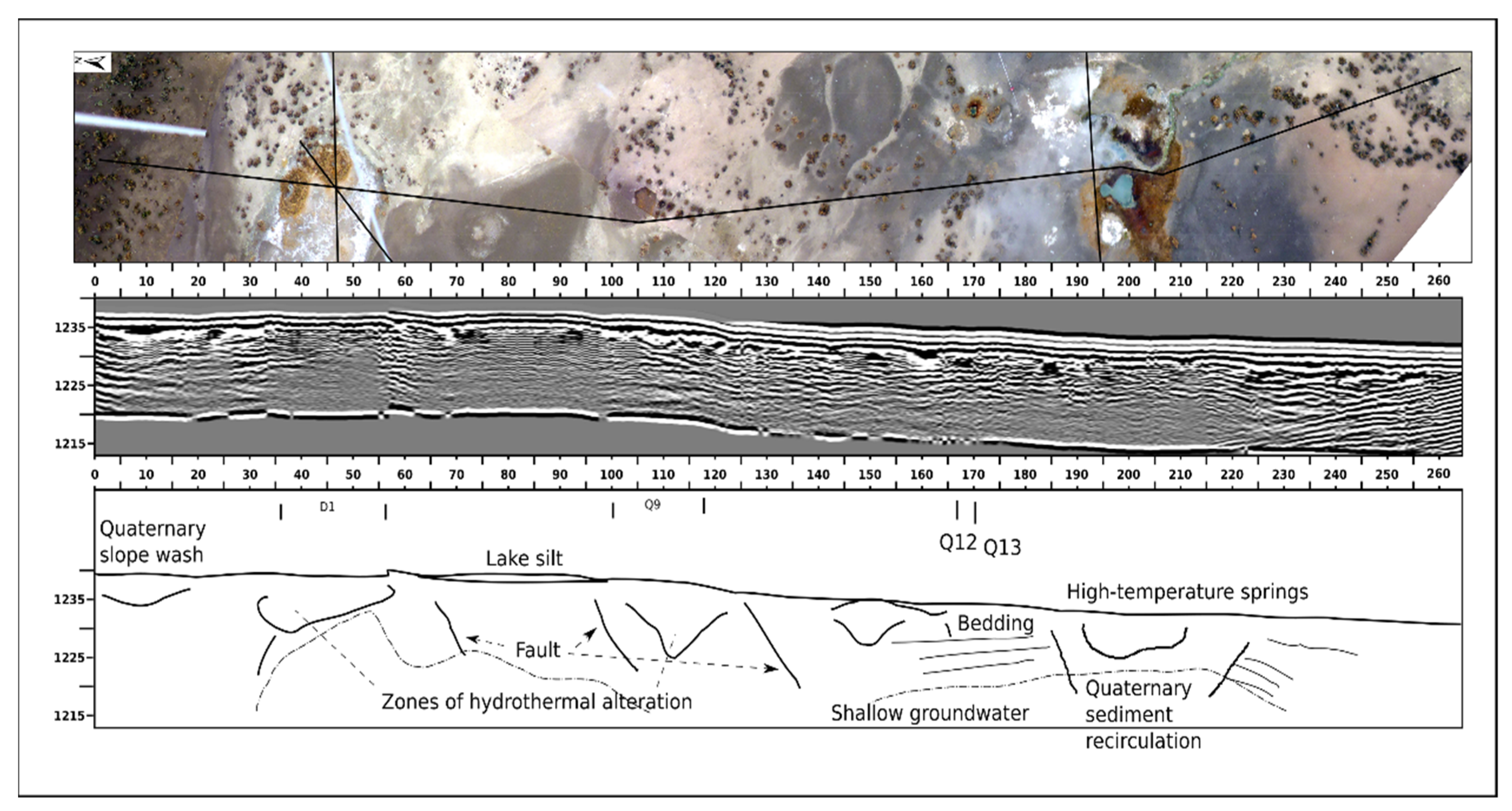


| Description | Surveyed Elevation (m) 1 | Depression Diameter (m) 2 | Interior Vertical Relief (m) 1 | |||
|---|---|---|---|---|---|---|
| D1 | Largest diameter depression in ACEC. Fine grained sediment common in depression floor, with blocks of sinter exposed in rim and collapsed blocks on depression floor. Two vegetated areas are present in eastern portion of depression, where two springs with no visible outflow are present. Seven other springs or steam vents are present in depression floor. Temperatures of active springs range from 38.6 to 72.5 °C. | 1236.72 | 32.05 | 1.77 | ||
| D2 | Broad depression with floor of moderately sorted silt and clay with clasts of sinter. Mound of sinter at center of depression protruding from sediment with <10 cm relief. Extent of depression marked by slope break coincident with transition to exterior blanket of well-sorted silt and clay. | 1237.63 | 21.25 | 0.93 | ||
| D3 | Two overlapping depressions, both with sinter blocks exposed in depression floor. No sinter is exposed in walls of the depression. Slope break at edge of depression floor consistent with transition to uniform exterior blanket of fine-grained silt and clay. | 1237.12 | 19.55 | 1.13 | ||
| D4 | 1237.06 | 11.65 | 0.58 | |||
| mean | 21.13 | 1.10 | ||||
| sdv | 8.40 | 0.50 | ||||
| Q1 | Sinter apron around slight depression of loose sediment. Apron slopes to the east, and is not apparent west of the depression, where slope increases toward the topographic ridge and sandstone outcrop west of spring area. | 1239.78 | 4.90 | 0.10 | ||
| Q2 | Extensive sinter apron around slight depression of loose sediment with blocks of broken sinter. | 1238.86 | 3.55 | 0.34 | ||
| Q3 | Extensive sinter apron around area of loose sediment and blocks of broken sinter. Pool edge sinter exposed around area of loose sediment. | 1238.80 | 3.35 | 0.12 | ||
| Q4 | Quaquaversal sinter apron with deep central depression. Vertical exposure in depression exposes 90 cm of pool edge sinter above 110 cm of laminated sinter interbedded with coarse sand and silicified root casts. Lower throat of depression broadens, and depression floor consists of loose, poorly sorted sand and silt with blocks of pool edge sinter up to 1.5 m collapsed from apron above. | 1239.80 | 3.30 | 2.61 | ||
| Q5 | Active spring pool with visually estimated 5 m of vertical relief visible in pool. Near horizontal sinter apron present around spring pool. | 1237.95 | 10.05 | n/a | ||
| Q6 | Quaquaversal sinter apron around slight depression. Outflow channel from Q5 passes west and south of apron. Apron more extensive to south and east of depression, following slope of local topography. | 1237.46 | 3.20 | 0.24 | ||
| Q7 | Sinter apron surrounding slight depression of loose sediment. Depression is near northern extent of apron, and apron slopes away to south and east with local topography. | 1235.46 | 3.40 | 0.29 | ||
| Q8 | Sinter apron exposed in half-circle on southern portion, dipping away with local topography. Flat area of loose poorly sorted sand and sinter clasts inside radius of pool edge sinter. Mound of loose well-sorted silt and clay in center of flat area. | 1236.25 | 16.45 | 0.40 | ||
| Q9 | Sinter apron around central depression. Active spring pool with cloudy brown water and green microbial mats covers 1/4 of depression floor. Inward-dipping pool edge sinter overhangs pool in depression. In March 2014, sinter apron was exposed, and in May 2014 was coated by 13 cm of moderately sorted silt and clay erupted from the depression spring pool. | 1235.39 | 4.95 | 1.00 | ||
| Q10 | Extensive sinter apron forming complete cap with no central depression, but thickness of sinter (0.4 m) is exposed by collapsed block, which reveals open space extending for 2.8 m laterally and 0.6 m vertically between the bottom of the sinter apron and a base of fine-grained sediment and sinter blocks. | 1236.13 | n/a | n/a | ||
| Q11 | Circular sinter apron with central depression. Sinter apron exposed and broken in blocks, with no sediment blanket coating the apron. | 1236.58 | 3.00 | 0.19 | ||
| Q12 | High-relief sinter apron with exposed pool-edge sinter surrounding small depression. Sediment in depression was poorly sorted silt up to 4 cm clasts of sinter. A fracture in the sinter apron extends N/NE from the depression. Water is present in fracture approximately 50 cm below ground surface, and depression sediment temperature is 59 °C 27 cm below the surface of the depression floor. | 1231.57 | 3.60 | 1.30 | ||
| Q13 | Small active spring pool rimmed with sinter apron. No current outflow but visible established outflow channel into depression of Q12. Spring vent in center of central spring pool. | 1232.11 | 1.00 | n/a | ||
| mean | 5.06 | 0.44 * | ||||
| sdv | 4.18 | 0.42 | ||||
| Sample ID | Associated Feature | Temperature at Sample Depth (C) | Sample Depth (cm) | TL Age (kya) | Uncertainty (±kya) |
|---|---|---|---|---|---|
| W4823 | Q4 | 29 | 220 | 30.7 | 7.9 |
| W4828 | High-temp springs | 84 | 40 | 9.2 | 1 |
| W4829 | Q12 | 59 | 27 | 18.1 | 2.1 |
| W4830 | D1 apron | 33 | 47 | 17.5 | 3 |
| W4831 | Q3 | 36 | 53 | 0.8 | 0.4 |
| W4832 | D1 depression | 28 | 24 | 12.8 | 4.4 |
Publisher’s Note: MDPI stays neutral with regard to jurisdictional claims in published maps and institutional affiliations. |
© 2021 by the authors. Licensee MDPI, Basel, Switzerland. This article is an open access article distributed under the terms and conditions of the Creative Commons Attribution (CC BY) license (https://creativecommons.org/licenses/by/4.0/).
Share and Cite
Mowbray, L.A.; Cummings, M.L. Silica Sinter and the Evolution of Hot Springs in the Alvord/Pueblo Valleys, Southeast Oregon, USA. Energies 2021, 14, 7186. https://doi.org/10.3390/en14217186
Mowbray LA, Cummings ML. Silica Sinter and the Evolution of Hot Springs in the Alvord/Pueblo Valleys, Southeast Oregon, USA. Energies. 2021; 14(21):7186. https://doi.org/10.3390/en14217186
Chicago/Turabian StyleMowbray, Leslie Allen, and Michael L. Cummings. 2021. "Silica Sinter and the Evolution of Hot Springs in the Alvord/Pueblo Valleys, Southeast Oregon, USA" Energies 14, no. 21: 7186. https://doi.org/10.3390/en14217186
APA StyleMowbray, L. A., & Cummings, M. L. (2021). Silica Sinter and the Evolution of Hot Springs in the Alvord/Pueblo Valleys, Southeast Oregon, USA. Energies, 14(21), 7186. https://doi.org/10.3390/en14217186




